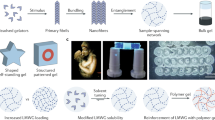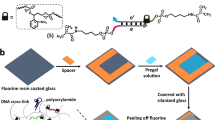Abstract
Protein-modified biomaterials can be used to modulate cellular function in three dimensions. However, as the dynamic heterogeneous control over complex cell physiology continues to be sought, strategies that permit a reversible and user-defined tethering of fragile proteins to materials remain in great need. Here we introduce a modular and robust semisynthetic approach to reversibly pattern cell-laden hydrogels with site-specifically modified proteins. Exploiting a versatile sortase-mediated transpeptidation, we generate a diverse library of homogeneous, singly functionalized proteins with bioorthogonal reactive handles for biomaterial modification. We demonstrate the photoreversible immobilization of fluorescent proteins, enzymes and growth factors to gels with excellent spatiotemporal resolution while retaining native protein bioactivity. Localized epidermal growth factor presentation enables dynamic regulation over proliferation, intracellular mitogen-activated protein kinase signalling and subcellularly resolved receptor endocytosis. Our method broadly permits the modification and patterning of a wide range of proteins, which provides newfound avenues to probe and direct advanced cellular fates in four dimensions.
This is a preview of subscription content, access via your institution
Access options
Access Nature and 54 other Nature Portfolio journals
Get Nature+, our best-value online-access subscription
$29.99 / 30 days
cancel any time
Subscribe to this journal
Receive 12 print issues and online access
$259.00 per year
only $21.58 per issue
Buy this article
- Purchase on Springer Link
- Instant access to full article PDF
Prices may be subject to local taxes which are calculated during checkout






Similar content being viewed by others
Data availability
Plasmids and data that support the findings of this study are available from the corresponding author upon reasonable request.
References
Lutolf, M. P., Gilbert, P. M. & Blau, H. M. Designing materials to direct stem-cell fate. Nature 462, 433–441 (2009).
Tibbitt, M. W. & Anseth, K. S. Dynamic microenvironments: the fourth dimension. Sci. Transl. Med. 4, 160ps24 (2012).
Baker, B. M. & Chen, C. S. Deconstructing the third dimension—how 3D culture microenvironments alter cellular cues. J. Cell Sci. 125, 3015–3024 (2012).
DeForest, C. A. & Anseth, K. S. Advances in bioactive hydrogels to probe and direct cell fate. Annu. Rev. Chem. Biomol. Eng. 3, 421–444 (2012).
Burdick, J. A. & Murphy, W. L. Moving from static to dynamic complexity in hydrogel design. Nat. Commun. 3, 1269 (2012).
Langer, R. & Vacanti, J. P. Tissue engineering. Science 260, 920–926 (1993).
Lee, K. Y. & Mooney, D. J. Hydrogels for tissue engineering. Chem. Rev. 101, 1869–1879 (2001).
Langer, R. & Tirrell, D. A. Designing materials for biology and medicine. Nature 428, 487–492 (2004).
Cushing, M. C. & Anseth, K. S. Hydrogel cell cultures. Science 316, 1133–1134 (2007).
Tibbitt, M. W. & Anseth, K. S. Hydrogels as extracellular matrix mimics for 3D cell culture. Biotechnol. Bioeng. 103, 655–663 (2009).
Seliktar, D. Designing cell-compatible hydrogels for biomedical applications. Science 336, 1124–1128 (2012).
Lutolf, M. P. & Hubbell, J. A. Synthetic biomaterials as instructive extracellular microenvironments for morphogenesis in tissue engineering. Nat. Biotechnol. 23, 47–55 (2005).
Zhang, Y. S., . & Khademhosseini, A. Advances in engineering hydrogels. Science. 356, eaaf362 (2017).
Tam, R. Y., Smith, L. J. & Shoichet, M. S. Engineering cellular microenvironments with photo- and enzymatically responsive hydrogels: toward biomimetic 3D cell culture models. Acc. Chem. Res. 50, 703–713 (2017).
Caliari, S. R. & Burdick, J. A. A practical guide to hydrogels for cell culture. Nat. Methods 13, 405–414 (2016).
Rosales, A. M. & Anseth, K. S. The design of reversible hydrogels to capture extracellular matrix dynamics. Nat. Rev. Mater. 1, 15012 (2016).
Ruskowitz, E. R. & DeForest, C. A. Photoresponsive biomaterials for targeted drug delivery and 4D cell culture. Nat. Rev. Mater. 3, 17087 (2018).
Luo, Y. & Shoichet, M. S. A photolabile hydrogel for guided three-dimensional cell growth and migration. Nat. Mater. 3, 249–253 (2004).
Hahn, M. S., Miller, J. S. & West, J. L. Three-dimensional biochemical and biomechanical patterning of hydrogels for guiding cell behavior. Adv. Mater. 18, 2679–2684 (2006).
DeForest, C. A., Polizzotti, B. D. & Anseth, K. S. Sequential click reactions for synthesizing and patterning three-dimensional cell microenvironments. Nat. Mater. 8, 659–664 (2009).
DeForest, C. A., Sims, E. A. & Anseth, K. S. Peptide-functionalized click hydrogels with independently tunable mechanics and chemical functionality for 3D cell culture. Chem. Mater. 22, 4783–4790 (2010).
DeForest, C. A. & Anseth, K. S. Cytocompatible click-based hydrogels with dynamically tunable properties through orthogonal photoconjugation and photocleavage reactions. Nat. Chem. 3, 925–931 (2011).
DeForest, C. A. & Anseth, K. S. Photoreversible patterning of biomolecules within click-based hydrogels. Angew. Chem. Int. Ed. 51, 1816–1819 (2012).
Wylie, R. G. et al. Spatially controlled simultaneous patterning of multiple growth factors in three-dimensional hydrogels. Nat. Mater. 10, 799–806 (2011).
Mosiewicz, K. A. et al. In situ cell manipulation through enzymatic hydrogel photopatterning. Nat. Mater. 12, 1071–1077 (2013).
Griffin, D. R. et al. Hybrid photopatterned enzymatic reaction (HyPER) for in situ cell manipulation. ChemBioChem 15, 233–242 (2014).
DeForest, C. A. & Tirrell, D. A. A photoreversible protein-patterning approach for guiding stem cell fate in three-dimensional gels. Nat. Mater. 14, 523–531 (2015).
Fisher, S. A., Baker, A. E. G. & Shoichet, M. S. Designing peptide and protein modified hydrogels: selecting the optimal conjugation strategy. J. Am. Chem. Soc. 139, 7416–7427 (2017).
Baslé, E., Joubert, N. & Pucheault, M. Protein chemical modification on endogenous amino acids. Chem. Biol. 17, 213–227 (2010).
Rabuka, D. Chemoenzymatic methods for site-specific protein modification. Curr. Opin. Chem. Biol. 14, 790–796 (2010).
Rabuka, D., Rush, J. S., deHart, G. W., Wu, P. & Bertozzi, C. R. Site-specific chemical protein conjugation using genetically encoded aldehyde tags. Nat. Protoc. 7, 1052–1067 (2012).
Kulkarni, C., Kinzer-Ursem, T. L. & Tirrell, D. A. Selective functionalization of the protein N terminus with N-myristoyl transferase for bioconjugation in cell lysate. ChemBioChem 14, 1958–1962 (2013).
Chen, I., Howarth, M., Lin, W. & Ting, A. Y. Site-specific labeling of cell surface proteins with biophysical probes using biotin ligase. Nat. Methods 2, 99–104 (2005).
Guimaraes, C. P. et al. Site-specific C-terminal and internal loop labeling of proteins using sortase-mediated reactions. Nat. Protoc. 8, 1787–1799 (2013).
Mao, H., Hart, S. A., Schink, A. & Pollok, B. A. Sortase-mediated protein ligation: a new method for protein engineering. J. Am. Chem. Soc. 126, 2670–2671 (2004).
Mazmanian, S. K., Liu, G., Hung, T. T. & Schneewind, O. Staphylococcus aureus sortase, an enzyme that anchors surface proteins to the cell wall. Science 285, 760–763 (1999).
Warden-Rothman, R., Caturegli, I., Popik, V. & Tsourkas, A. Sortase-tag expressed protein ligation: combining protein purification and site-specific bioconjugation into a single step. Anal. Chem. 85, 11090–11097 (2013).
Komatsu, N. et al. Development of an optimized backbone of FRET biosensors for kinases and GTPases. Mol. Biol. Cell 22, 4647–4656 (2011).
Hermanson, G. T. Bioconjugate Techniques (Academic, Cambridge, 2013).
Farahani, P. E., Adelmund, S. M., Shadish, J. A. & DeForest, C. A. Photomediated oxime ligation as a bioorthogonal tool for spatiotemporally-controlled hydrogel formation and modification. J. Mater. Chem. B 5, 4435–4442 (2017).
Kloxin, A. M., Kasko, A. M., Salinas, C. N. & Anseth, K. S. Photodegradable hydrogels for dynamic tuning of physical and chemical properties. Science 324, 59–63 (2009).
Bieniarz, C., Young, D. F. & Cornwell, M. J. Chromogenic redox assay for β-lactamases yielding water-insoluble products. I. Kinetic behavior and redox chemistry. Anal. Biochem. 207, 321–328 (1992).
Kuhl, P. R. & Griffith-Cima, L. G. Tethered epidermal growth factor as a paradigm for growth factor-induced stimulation from the solid phase. Nat. Med. 2, 1022–1027 (1996).
Fan, V. H. et al. Tethered epidermal growth factor provides a survival advantage to mesenchymal stem cells. Stem Cells 25, 1241–1251 (2007).
Acknowledgements
The authors recognize and thank R. Seifert and D. Hailey of the University of Washington Garvey Imaging Center for their ongoing support and advice, F. Watt and T. Hiratsuka (King’s College London) for helpful discussion on visualizing the MAPK activation, M. Matsuda (Kyoto University) for a gift of the HeLa cells transfected with the EKAREV FRET sensor, as well as R. Warden-Rothman and A. Tsourkis (University of Pennsylvania) for providing the pSTEPL plasmid37. The authors thank B. Badeau for assistance in synthesizing N3-oNB-OSu, S. Adelmund for providing BCN-OSu and A. Im for help with the protein purification optimization. We acknowledge support from S. Edgar at the UW Mass Spectrometry Center as well as that from the NIH and N. Peters at the UW W. M. Keck Microscopy Center (S10 OD016240). This work was supported by a University of Washington Faculty Startup Grant (C.A.D.), a Jaconette L. Tietze Young Scientist Research Award (C.A.D.) and a CAREER Award (DMR 1652141, C.A.D.) from the National Science Foundation.
Author information
Authors and Affiliations
Contributions
For this manuscript, J.A.S. and C.A.D. conceived and designed the experiments; J.A.S. and G.M.B. performed the experiments; J.A.S. and C.A.D. analysed the data and prepared the figures; J.A.S. and C.A.D. wrote the paper.
Corresponding author
Ethics declarations
Competing interests
The authors declare no competing interests.
Additional information
Publisher’s note: Springer Nature remains neutral with regard to jurisdictional claims in published maps and institutional affiliations.
Supplementary information
Supplementary Information
Supplementary Figs. 1–23, Supplementary Table 1, Supplementary Methods, Supplementary Video Captions 1–3, Supplementary References 1–5.
Supplementary Video 1
Scanned xy planes of multiphoton ‘cell’ pattern from Fig. 4f–i rendered using Imaris.
Supplementary Video 2
Scanned xz planes of multiphoton ‘cell’ pattern from Figure 4f–i rendered using Imaris.
Supplementary Video 3
Time-lapse FRET quantification of HeLa cells expressing EKAREV.
Rights and permissions
About this article
Cite this article
Shadish, J.A., Benuska, G.M. & DeForest, C.A. Bioactive site-specifically modified proteins for 4D patterning of gel biomaterials. Nat. Mater. 18, 1005–1014 (2019). https://doi.org/10.1038/s41563-019-0367-7
Received:
Accepted:
Published:
Issue Date:
DOI: https://doi.org/10.1038/s41563-019-0367-7
This article is cited by
-
Irreversible light-activated SpyLigation mediates split-protein assembly in 4D
Nature Protocols (2024)
-
Reconfiguring hydrogel assemblies using a photocontrolled metallopolymer adhesive for multiple customized functions
Nature Chemistry (2024)
-
Tricolor visible wavelength-selective photodegradable hydrogel biomaterials
Nature Communications (2023)
-
Middle-out methods for spatiotemporal tissue engineering of organoids
Nature Reviews Bioengineering (2023)
-
Whole-genome screens reveal regulators of differentiation state and context-dependent migration in human neutrophils
Nature Communications (2023)



